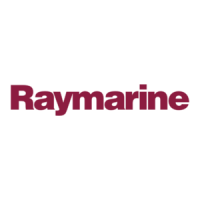Chapter 1: Overview 7
Acousticnoiseisalways presentand thesesoundwaves caninterfere
withthe operation of the transducer. Ambient(background) noise
from sources such as waves, fish, rain and other vessels cannot be
controlled. Carefully selecting the transducer’s mounting location
can minimize noise generated by the vessel’s propeller(s), shaft(s),
machinery, and other echo sounders. The lower the noise level, the
higher the echo sounder gain that can be used, and the better the
Fishfinder’s performance.
CAUTION:
To ensureaccurate readings, DO NOT mount thetransducer in
an area of turbulence or bubbles:
• near water intakeordischargeopenings
• behind strakes, fittings or hullirregularities
• behind eroding paint (an indication of turbulence)
Choosea location where:
• Thewaterflowingacrossthehullissmoothestwithaminimumof
turbulence and bubbles (especially at high speeds).
• The transducerwill be continuously covered bywater when the
boat is moving. If the transducer is mounted near the sideof the
boat, it may be exposed when the boat is turning.
• The transducerbeam is unobstructed by the keel or propeller
shaft.
• There is a minimum deadrise angle.
• There is adequateheadroominsidethevesselfor theheightof the
thru-hull housing, tightening the nuts, and removing thevalve
assembly insert.
Transom Mount Transducer
• Singledrive boat- Refer to Figure 1-1 . If your boat has one pro-
peller(outboardorinboard),mountthetransducerabout18"(455
mm)to thesideof theboat’s centerline. To reduce any interfer-
ence caused by air bubbles, choosethe side on the downstroke of
the propeller (usually the starboardside).
• Twin drive boat - If your boat has twin propellers (outboard or
inboard-outboard),mount the transducer between the drives near
the centerline of the boat. If the boat will be operated at high
speeds,the transducer may be mounted closerto thecenterlineof
the hull.

